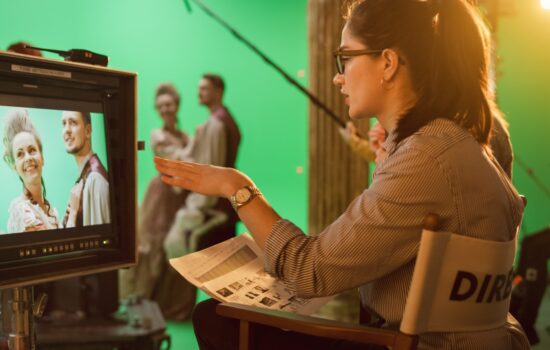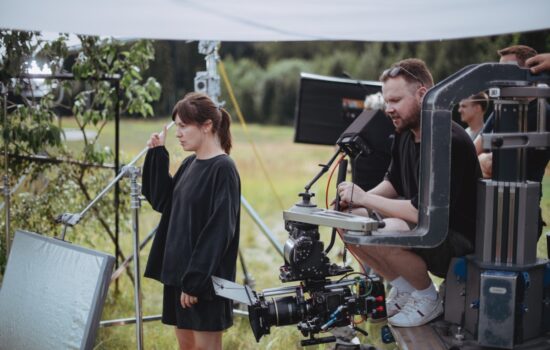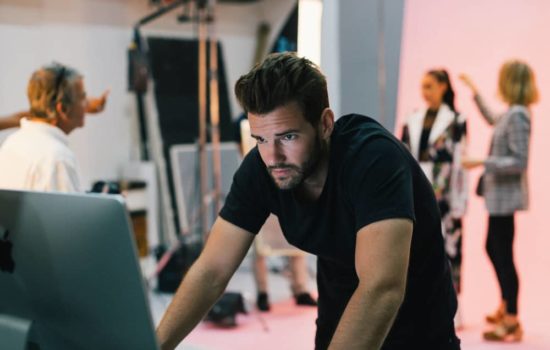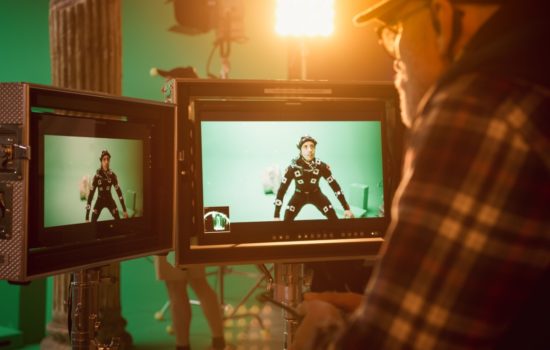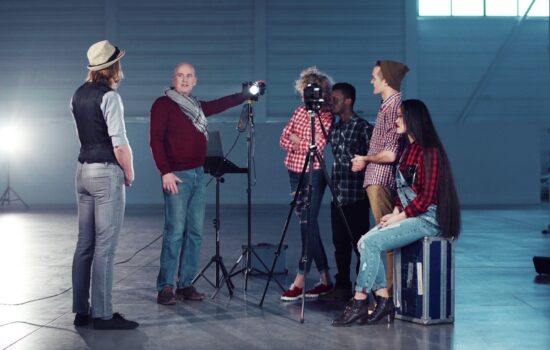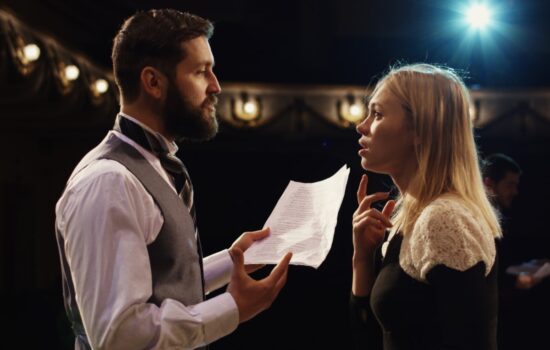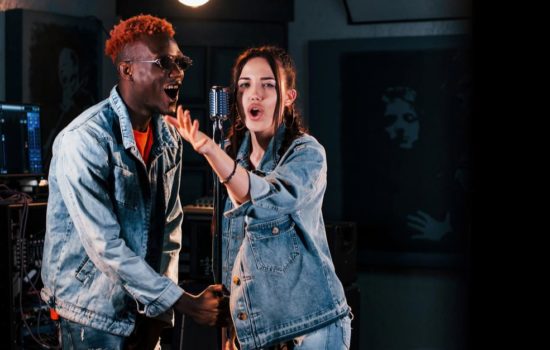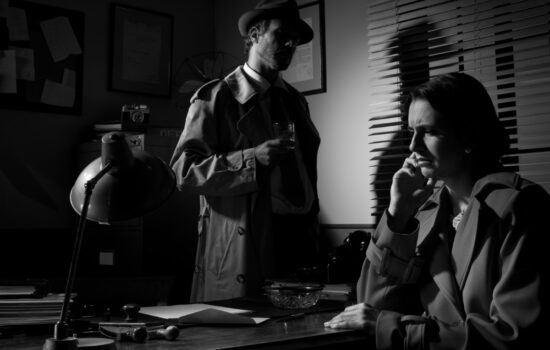Gaffer
Career Overview
The Gaffer, also called the Chief Lighting Technician or Chief Electrician, is the most senior position within the electrical department and leads it on a film set. They are typically hired during pre-production to support and collaborate with the movie’s Cinematographer during principal photography. Together, they work to achieve the desired cinematic aesthetic.
Alternate Titles
Chief Lighting Technician, CLT, On Set Gaffer
Avg. Salary
$54,7381
Salary Range
$19K to $129K1

How To Become a Gaffer
People also ask
Career Description
The title of Gaffer is given to the person who is in charge of the electrical department on a production. This person oversees the electric needs of a project, especially as it pertains to the lighting needs on a film set.
The Gaffer works with a team of Film Electricians to ensure that the intended lighting scheme devised by the Director, Director of Photography, and other involved creatives is executed according to plan. The person who is second-in-command under the Gaffer is the Best Boy Electric.
This detailed breakdown of what a Gaffer does offers a great overview of the job.
A Gaffer usually onboards a project during the pre-production phase and remains with it until principal photography wraps. They work closely with the Director, Cinematographer, and Key Grip during these phases of production.
The Gaffer’s responsibilities include:
- Determining the lighting vision and plan in collaboration with the Director, Cinematographer, and other involved parties.
- Noting special lighting needs upon reading the script.
- Deciding what kind of lighting and associated equipment should be used for principal photography within the confines of the production’s budget.
- Choosing the rest of their electrical team and providing them with the lighting plan.
- Overseeing the execution of the lighting plan on set and providing any necessary adjustments to what the rest of the electrical team implements.
To learn more about building a career as a Gaffer/CLT, we spoke to lighting professionals in different markets around the US and in the UK, including:
- Bob Bates (Stranger Things, Mudbound, Trumbo)
- Harlon Haveland (No Time to Die, Solo: A Star Wars Story)
- Paul McIlvaine (Saving Mr. Banks, Walk Hard: The Dewey Cox Story, Little Miss Sunshine)
- Andrew Mueller (Hell’s Kitchen, Legion)
- Jaim O’Neil (Renfield, Bottoms, Claws)
- Cole Pisano (music videos for Olivia Rodrigo, Billie Eilish, Nick Jonas)
What do Gaffers do?
The short answer is the Gaffer is the head of the Lighting Department and oversees the crew and duties that they provide in support of the film. Gaffers work directly under the Director of Photography from pre-production until show’s wrap.
I’ve often described the Gaffer’s role this way: imagine a film crew pushing a huge boulder up a hill and the Gaffer makes sure there’s no pebbles getting in the way to stop the crew’s momentum.
You’re pretty much the Director of Photography’s right-hand man, in a sense. You’re there to basically implement his vision and the lighting of the scene.
You start a setup with camera and everything. Whether it’s a comedy, or a drama, or a horror movie, he’s gonna say the style of lighting that he wants to see and then it’s your job to get that going, and rough that in, knowing the different units to use and whatnot.
When you go out and scout for a movie, you’re pre-prepping, to come up with that pre-visualization of lighting prior to stepping on a set.
Gaffers are in charge of the Lighting Department, so they handle all the power and electrical needs for the show. You have a rigging crew that works under you and a Rigging Gaffer, and he is basically my guide that is putting in all the pre-lighting and pre-power to the sets and everything.
You’re in charge of that department and making sure that the finances of the department are run correctly. There’s a lot of budgets that you’re handed, most of the time. (Sometimes you’re not.) That’s basically the job: to light the set in collaboration with the Director of Photography.
A Gaffer, or Chief Lighting Technician, is the head of the Lighting Department on feature films, television series, commercials and/or music videos. Gaffing is an exciting job that I would recommend to anyone that appreciates light and shadows and has a creative personality on how to achieve different moods and looks.
What does a Gaffer do? I would say the most important thing a Gaffer does is diplomacy. It is a position where you’re required to learn and know an incredible amount about technology, power, lighting, and equipment, but at the same time, you’re also talking constantly with the Cinematographer, the First Assistant Director, the Line Producer, the Transportation Department, the Grip Department. There’s very few departments that don’t intersect with lighting.
In that way, you’re also responsible for knowing what all of those other individuals and departments are trying to accomplish and what their goals are so that you can work in tandem with them and you’re not stepping on each other or overlapping. It’s a lot of moving parts. Having great communication skills and knowledge of what everyone else is doing is, I think, the cornerstone of having a successful career in lighting.
Really, the term now that’s being used is Chief Lighting Technician; that’s kind of a move that has happened in the last ten to fifteen years as the job has gotten much more technical, and the careers and the unions are trying to reflect that in the terminology.
Then the older, more colloquial term of years past was Best Boy. Now it’s Assistant Chief Lighting Technician. You used to have a Dimmer Board Operator. Now it’s called the Lighting Console Programmer. Then those will all be abbreviated: Chief Lighting Technician will be CLT, [then] ACLT, LCP, things like that.
A Gaffer is the person in charge of the Electrical Department.
The Gaffer is the head of the Lighting and Power Department on a film set. They work in pre-production and production to help achieve the desired cinematic image through setting up lights and running cables.
Often, the Cinematographer will draw lighting plots as a reference point to help establish a plan. Other duties will include negotiating with Producers and Production Managers on the electric budget, cutting deals for equipment, and hiring crew.
What Is the role of a Gaffer?
A Gaffer’s responsibilities consist of many things. Since they’re the head of the Lighting Department, they oversee all of the objectives of lighting on set per the Director of Photography’s (DP) wishes. They are responsible for helping the DP and the Director of the project by offering their desired look for the film.
The Gaffer helps the DP set the mood and look of the film through lighting. A Gaffer is well-versed in lighting equipment. Knowing what the different fixtures can do and offer helps expedite the wishes of the DP to give them their desired look.
The film set can be very fast-paced and a Gaffer has to be quick to react and help resolve potential issues. Knowing his/her trade and what the different light fixtures can offer only helps to expedite the set ups. I feel if you do not know the equipment, what it can do for you, and how to use it, then you would have a short/limited career as a Gaffer. Learning the lighting/electric equipment is the first step to working on this department.
A Gaffer is the person in charge of all the lighting and the power for around camera and on set. So, all the specialist lights, LED, and practical lights on set.
You have a Best Boy, which is an Assistant Chief Lighting Technician, and his job is pretty much to run the department. While you’re on set lighting, he’s in the background. He’s not on set.
You just oversee him [and] make sure that you’re not spending too much money, you don’t have equipment that’s just sitting around not being used and is either sent back (if you don’t need it) or coordinated to make sure, for upcoming sets and everything, that stuff’s gonna be there and ready to be plugged in and used. That’s pretty much it.
Job duties will change somewhat depending on the type of job, but at the core of it, across commercials, TV, features, it involves a conversation with the Cinematographer about the lighting goals, what they are looking to accomplish.
You’re there to make sure that you have the power to facilitate that, that you have the right equipment, that you have the right manpower, that you have the right gear to do certain locations— because it’s always changing. You’re never gonna do the exact same thing twice, so you need to have something ready for flexible situations.
In that regard, it’s learning how to use tools that are flexible: lighting instruments that can be used for an entire week in multiple different locations, or setups, or places. Being ready for anything.
Typically, each job you’d start with some kind of prep or production meeting where you’d go over the content, the script, the commercial pitch—whatever that is. You gotta learn about that, then from there, you would have probably some more one-on-one dialog with the Cinematographer and the Unit Production Manager where you discuss the goals, their budget, and the time constraints.
Then you would do a tech scout where you’d go look at the locations. You map out the plan, the schedule, and what each setup and shot is hopefully going to look like. Oftentimes, they change but there’s a foundation there that you’re working with.
Once you’ve got your tech scout done, and your prep, and your meetings and all that, then you start to make your plan of what equipment you’re gonna need for certain days and places, the manpower you’re gonna need.
Then some of that starts to be delegated out to the ACLT, and in certain situations, you might have a big enough job, like the one I’m on now where we have an entire rigging crew, an entire first unit crew, a Fixtures Department. It kind of “tree branches” out as things get bigger because you need to be able to delegate and assign things. It’s just too much for one person to constantly handle.
Once all of that is done, then you’re looking at what happens on set on the day when you’re lighting, when you’re showing up with your whole plan. Oftentimes, that is going off what you discussed on the scout so that you’re ready. It’s having the power laid in ahead of time, having your lights set up [and] ready to go so that on the day, you’re not having those same conversations, and slowing things down.
At that point, you get to have the conversations about the craft, and the aesthetic, and making the more artistic choices when you’re there with the Cinematographer and the camera and you have things set up and you can see it in real-time.
A Gaffer’s basic responsibilities begin with organizing the lighting crew. Starting in pre-production, figuring out the lighting needs for the job at hand. Design any lighting plots required and write up all equipment lists. Each set should have a schedule of extra equipment and crew requirements submitted for budget approval.
At the end of the day, I like to think of a Gaffer’s responsibility this way: how to manage the crew and equipment from shot to shot, scene to scene, beginning of the workday to wrap, from Day 1 of production until the show’s wrap.
A Gaffer’s lifestyle and work schedule constantly vary because it’s a freelance position. Sometimes they’ll work ten days straight, for ten to twelve hours per day, with only one or two days off. Other times it’s just one day in a week. It really depends on when the jobs come in and how often the Gaffer wants to work.
Working isn’t limited to just being on set. A lot of days are scouting, prepping, or working from home. When the jobs start is also up in the air and unique to each job. Sometimes there’s a day shoot and then a night shoot right after, so Gaffers must manage their own downtime.
They shouldn’t forget about their personal life but they also need to develop relationships with people who are okay with plans changing last minute. Gaffing can be a turbulent life with long stints of unexpected downtime.
Why is a Gaffer called a Gaffer?
People often don’t know what a Gaffer is because their name doesn’t provide much information about their job. The title originated from the word “gaff,” which is a hooked pole used to adjust stage lights in a theater.
Salary
According to ZipRecruiter, the average annual salary for a Gaffer based in Los Angeles is $62,410. The salary range for Gaffers runs from approximately $32,837 to $102,342.
However, these salary ranges can vary further based on where a Gaffer lives, how much they work in a given year, the type of projects for which they are hired, and their union status.
Non-union Gaffers set their own day rates, which will typically be less than those of union Gaffers. The Gaffer union – IATSE – sets a pay scale for its members with which union productions must comply.
How much do Gaffers get paid?
On a union job, you’re looking at anywhere from $2,800 to $4,000 a week. That’s union in LA or New York. Other parts of the country, the scales and the wages for union jobs are different. I know that it’s less, but I’m not as familiar with those contracts.
Most of the CLTs that I know also own equipment that they use. If someone’s really looking at a long-term career in lighting, starting a company is often very valuable—especially nowadays when there’s so much variety in equipment and lighting.
It’s very beneficial for people to own the core tools that they’re gonna repeatedly use because everyone starts to get their style and how they like to work: the fixtures, the lighting that they like to use. To repeatedly and reliably create those aesthetics, you’re gonna wanna own some of those pieces of equipment that you can rent to the vendor or the job so you know you’ve always got it with you.
To think of an analogy, it’d be like hiring a Dentist but then just having them show up at a random dental office. They could probably work their way through the day and do a procedure, a cleaning and all that stuff, but they’d be using someone else’s tools.
You’re maybe looking for it and figuring it out, but if you show up and you’ve got your own office with your own tools and your own thing, you’re much more prepared. There’s more time saved. The process becomes tighter and faster because you’re working with your own lighting tools.
It’s all scales. I know CLTs that just own one small cart of like five or six lights and that’s enough. They know that they can bring that, then anything else they need they’re gonna rent: the power, the bigger lights, the other things. I know people that own huge semi-truck trailers full of things, and for them, it’s like, “This is what I need. You’re gonna hire me for a job, this truck comes with me, and this is how we’re gonna get it done.”
So, salary-wise you could easily do $150,000 a year on your wages. But if you’re savvy, you’re in a big enough market for it, and you own the equipment, too, then there’s a lot more potential for that to go a lot higher. There’s situations that I’ve been in where the CLT, when you account for that, is making more than the Cinematographer. It’s not always the case, but it certainly does happen.
A Gaffer’s salary depends on the project. Typically, on non-union commercials, corporate videos or music videos they are based on a 10 or 12 hour day and that rate can vary between $450 USD to $750 USD. On Union projects, most feature films and TV series, you can make between $25/hr to $60/hr plus benefits (insurance and pension).
I would say, depending on your market and what type of projects you’re offered, a Gaffer can make anywhere between $60,000 to $90,000 a year. And that salary can fluctuate drastically each year because of what projects are offered.
Depends on the experience a Gaffer has for how much they can ask for. But roundly £450 ($605) – £570 ($767) a day.
There’s a wide range of compensation for working as a Gaffer, the biggest factor being the size of the budget of that particular job. From big-budget features to one-day locale commercials, the money offered will vary.
There are other considerations besides compensation to weigh before accepting or declining a job. New contacts made from a low paying job could lead to much better-paying jobs. The job may offer something new or unique that one hasn’t experienced before. Each job has to be weighed separately, compensation is just one part.
It really depends on where you get in at. In the different markets, it’s just what the pay is, what the hourly rate is. If you get in as a Gaffer in Los Angeles in the union, I think it’s like $52 an hour starting, then you get a three percent raise every year. It might be a little bit higher in New York — I don’t know what that rate is — only because of the cost of living.
But in the smaller markets like Atlanta or New Orleans or New Mexico, it’s probably around $38 an hour for a Gaffer in those markets. You work eight hours. You get time and a half after eight, then it goes to double-time after twelve, so with those hourly rates, if you do the math, probably $400 or $500 a day.
Who is a famous Gaffer?
You would be hard-pressed to find a Gaffer famous enough that the average person would know who they are. That being said, many experienced and esteemed Gaffers are very well-known within the filmmaking community.
Some of these individuals include Earl Gilbert, John Higgins, and Jim Plannette.
Hey, what do you think about trying our new Film Career HelperFilm Career Helper really quick? It’s totally free and could help get your career moving fast! Give it a try. It’s totally free and you have nothing to lose.
Career Outlook
Some specialties like acting or directing can be learned on the job, but a Gaffer must come to a project equipped with the skills expected of them. As a result, competent Gaffers are always in demand.
Because a Gaffer must have comprehensive know-how of not only the technical aspects of electricity and lighting, but also the creative implications of how those tools are used for film, a Gaffer with an established reputation can likely have a long and successful career.
Gaffers work closely with Cinematographers, and this video explains that collaborative process through the eyes of the DPs.
As with most other specialties, though, Gaffers are still reliant workwise on the number of films in active production. For this reason, they may work on only one or two projects a year.
Key to staying employed as a Gaffer is being open to opportunities outside of film. Television shows and commercials also require the services and skillsets of a Gaffer, which make them complementary fields to film that Gaffers should consider pursuing as well.
What is a Grip vs Gaffer in film?
The Gaffer on a film leads the electrical department. The most senior Grip, referred to as the Key Grip, leads the rigging department. In other words, the Key Grip is in charge of the equipment that the Gaffer and their department use to hang the lights for a film.
Career Path
A general film school education may be part of an aspiring Gaffer’s career. There they can learn the responsibilities of a Gaffer and gain on-set experience with student films.
However, getting a degree in film isn’t requisite for a successful career. If film school isn’t desired or an option, an aspiring Gaffer can begin to learn the skillsets required of them by joining crews as a Production Assistant – specifically, a PA working in the lighting department on a film.
What would happen if there was no Gaffer on set? This video demonstrates exactly why this position is a must during principal photography.
The importance of working on films no matter the size cannot be overstated. Even through student films, short films, and low-budget films, an aspiring Gaffer can both learn the trade and make connections that may lead to being hired for future and more prominent projects.
And while creativity is part of a Gaffer’s job, the technical knowledge of how to work with lighting and electricity is paramount. That’s why aspiring Gaffers should consider going through formal Electrician training to build those skillsets.
How do you become a Gaffer?
There’s no set protocol for becoming a Gaffer. It could be as simple as knowing a DP who needs a Gaffer and you offer your services. The film business is built on relationships and contacts. The more jobs you are on, the bigger your list of contacts becomes which may lead to more opportunities to advance.
The best scenario may be to take small steps and learn all the intricacies of the Lighting Department’s responsibilities. Commercials, music videos, and corporate jobs are a great place to start out and build a career.
There are many paths to becoming a Gaffer but the one skill that everyone must develop is how to sell yourself as the Gaffer.
Much like every other part of this business, there’s no roadmap that is guaranteed. There’s myriad ways to accomplish that career path. What has worked for one, or a dozen or a hundred other people might not work for someone else because so much of it is circumstance, timing, relationships, where you’re working, what the environment is like, and what the content demands are like.
There’s certain things that will help but there’s no guarantees. For people who excel in school and are used to like, “I’m gonna graduate this year, and that means I get this, and then that”…If you’re used to predetermined incremental career achievements, well that’s not really the case with this career path. I think the people that respond best to it are the ones that can see opportunity in that and know that they can be flexible with their plan and learn and adapt.
To have long-term success you’re gonna be working for and underneath other people, trying to find ways to work as an On Set Electrician, work your way up as an Assistant Chief Lighting Technician, then eventually to Chief Lighting Technician.
But there are other ways to do that, like a show, for example. For example, a show like Legion was very large and they would shoot so much that they had a full-time second unit. That was my relationship on the show: gaffing all of their second-unit days, their stunt days, their effects days. They would do double-up units sometimes where you’re shooting simultaneously with another unit. There’s a lot more of that now than there used to be.
Oftentimes, if you start a career path as a Lighting Technician. Then perhaps a CLT on the main unit will say, “Okay, well, on this day and this day we need a second unit, or we need an effects unit. So we’re gonna send so-and-so from our department to go over and be the CLT for that unit,” and you’ll get bumped up for a couple days and go be in charge of that.
That’s beneficial to everyone because you know the content, the people, the show, the look, and so there’s a lot more opportunity for that situation now.
That’s kind of how I got my start. I made those relationships with other people who would bring me in and hire me for that kind of thing because they liked the way I worked, they knew who I was, and they could count on me to go pick up the slack on those other units when they had to pay attention to the main unit. But it’s different for everyone.
This might be the hardest question that I get asked….The only response I know is that you have to be passionate about lighting and filmmaking. I see many people that are asked to help in the Lighting Department and given the title Gaffer, but there is a lot that comes with that classification.
You have to have an understanding of lighting and how to shape lights and I also feel like you have to be passionate about filmmaking to be good at the task. So much of our job is knowing what fixture to use and when to use it as well as what application to use it in. Film sets can be so fast-paced and expensive, you have to be efficient at the very specific job of lighting.
There’s a lot of avenues. I got in the union on Dante’s Peak about twenty-six years ago. You have to do permit days now. In Los Angeles, you have to do thirty permit days to get into the Local, in Los Angeles, it’s the 728. [With] the Local in New York, 52, you have to do thirty permit days, then you have to apply to the union, and they have to let you in.
In the national market, meaning, like Atlanta, New Orleans, the other markets, those are actually right-to-work states so you can find somebody in the business to help get you started. You don’t really need to do the thirty days. Once you get to a certain point, you can apply for the union and then get in, and you just work your way up through the ranks. I came up through rigging on up…so, at the bottom on up.
By doing it that way, I know what every job in my department takes, whether it be fixtures, whether it be rigging, whether it be On Set Electricians, whether it be a Dimmer Board Operator. Best Boy, Rigging Gaffer, Rigging Best Boy: I’ve done all the positions, pretty much, in my department. It helps a lot with scouting.
Implementing what a Director of Photography wants to do, whether it’s on set or on stage, I know what it’s gonna take with my experience—the cost for lighting, the manpower to get it done.
Then there’s the non-union way. A lot of people go through the non-union movies or promotions. They used to be a little bit heavier back in the day, but a lot of the non-union stuff has become like our movie-of-the-weeks or tier ones that are now union. They’re just at a lower pay scale.
You work your way up through the Electrical Dept. You can skip this but then you will have missed a lot of learning experiences that make you into a good Gaffer. Once you Gaffer, it’s hard to learn new things because you are not working with other Gaffers and learning from them.
How can I be a good Gaffer?
Many people break into gaffing by working on student and short films. As their reputation grows and they get to know more Cinematographers they’ll move onto larger sets and longer shoots.
The best way to become a competent Gaffer is to start with an entry-level position in the lighting crew. [This means typically working as an Electrician or Lamp Operator. Internships or working for free on low-budget gigs are a great approach because they offer a chance for practical experience.]
Experience & Skills
The decision to go through a film program can be useful for an aspiring Gaffer, as it offers some opportunity to gain on-set experience. As mentioned, though, it’s hardly a requirement to become a successful Gaffer.
What is important, though, is gaining the very concrete knowledge and skills of how lighting and electricity needs must be safely and creatively managed on set. As a result, getting some form of Electrician training certification can be immensely helpful for a Gaffer’s career.
Gaffer Julian White describes how those in his role use filters and diffusion.
No aspiring Gaffer can make the leap from PA to Chief Lighting Technician without considerable experience and expertise. For this reason, they must be proactive in getting onto projects to gain those skills.
What experiences and skills do Gaffers need to have?
Safety is one of the biggest aspects of being a Gaffer. Within their line of work, it’s easy to get someone killed or start a fire with the lighting equipment. Having experience, especially in safety practices, as a Set Lighting Technician or doing power distribution is crucial.
Additionally, there are a lot of politics with Producers and other department heads, especially around budgets. Ultimately, the Gaffer is there to serve the Director and Cinematographer but they’ve still got to interact with everyone else and remain professional.
It’s exposing yourself to the process and the duties of other parts of filmmaking. I’ll say that about any position on the film set. I think it’s incredibly negligent for, like, a Director, to only have ever directed. If you spend a small bit of time on set in any other duty or capacity, you suddenly realize what it takes to accomplish something when it’s asked for.
There’s huge value in that. If I’m gonna show up as a CLT and point, “Hey, I need this over there. I need that over there. This has to happen at this time,” well, that’s great, but if I don’t have a concrete understanding of every step that happens along the way to get that result, then I could be sabotaging myself or the time that it takes to do those things.
Ultimately, at the end of the day, that’s what it’s all about, understanding how long it takes something to happen and how to get that. You can sit there and talk with the Cinematographer and say, “Okay, for this scene we need this hard light coming through a window, we need a soft bounce on the camera right side to fill this in, and we need a little flicker effect in the background for a car driving by or something coming through another window.”
There’s like twenty ways to accomplish each one of those things and you can spend all day figuring it out. Or, if you have the toolset, you’re gonna say, “Well, in this situation, this is what I’m gonna do for the light through the window because I know there’s only so much room outside so it’s gonna be faster,” and ultimately, that’s what your job comes down to.
Anyone can make a beautiful image if you have unlimited time to accomplish it. It’s knowing how to quickly get that result in a flexible way. If you understand what it takes for other people to do it when you ask those things, that’s where the success comes. It’s being quick and being flexible because you understand the process.
Education & Training
If an aspiring Gaffer is interested in getting a formal education in film, they should consider one with a strong production program – as opposed to film studies – so that they’ll have the chance to work on student films and gain that experience.
On account of how closely Gaffers work with DPs, an aspiring Gaffer may specifically want to go through a cinematography program to boost their expertise in the field.
What’s on a Gaffer’s belt? This video explains the many tools of the trade.
Otherwise, an aspiring Gaffer must search out what productions are happening locally and seek to become part of them – likely as a PA if they are just beginning their gaffing career.
If necessary, a move to larger production cities like Los Angeles, New York City, Chicago, or Atlanta might be needed to both gain experience and stay employed more regularly.
Do Gaffers need to go to film school?
I didn’t go to film school. I was actually a Firefighter for a couple years before I got in the business. I’m fourth generation. My dad did it, my grandfather, my great-grandfather.
It’s a lot of on job training. Film school’s gonna teach you the basics; I’d say it’s more the cinematography and the art of lighting. You really have to be there, hands-on. It’s different when you’re in a class in front of twenty people than when you’re standing on set in front of a hundred people and you’re trying to implement lighting and there’s chaos going on.
Sometimes sets can be very chaotic, in a way, especially big action films. So you need to not be intimidated, especially by the different Directors, Actors, Producers and other crew members around you.
It’s a rewarding career. It’s not like you’re going to the same office every day. I’m doing the TV show Claws right now in Louisiana. In the last couple years, I did Rampage, Bad Boys for Life, Lady and the Tramp, Unhinged, and The Secrets We Keep. I’ve gone from a Will Smith big action movie down to a small, little, dramatic period movie that’s in the ‘50s—it’s always changing.
The crews change, for the most part. I travel a lot for work; I’ve worked at all the different areas except New York. You get to work with different people all the time. It’s not just the same people that you would see every day. I kind of like that.
No, not really. There are some Gaffers who went to film school but you need some electrical knowledge to make the set safe. A lot of Gaffers in the UK come from an Electrical background and qualifications.
I’m not gonna be someone that outright says that it’s good or bad. It’s circumstantial. I went to film school. I did the four-year thing, and there was certainly benefit to it, but I’ve never once had to show my degree to anyone to get a job.
If you’re gonna invest in film school, you can’t think of it like, “Oh, I have this diploma and that’s gonna mean something to anyone,” because it really doesn’t. No one cares that you have a diploma. What matters in that situation is what relationships you build and where that can take you. That’s the benefit.
Looking back, I probably could’ve dropped out after my third year in school and still had a fine career path. But when you’re in it doing it, you’re like, “Oh my god. I’m not gonna get a diploma.” We have a whole lifetime of being conditioned to think that way.
It’s one of those things where the value is not the piece of paper; it’s the relationships and the path that it can start you on. Sometimes that works really well for people, and for other people, it’s a waste of money. Again, because there’s no perfect blueprint or roadmap for this, it’s all very circumstantial.
Film schools are a great place to learn and make mistakes before it matters. Many aspects of the film business can be experienced before choosing a career path. The breadth of knowledge obtained from film school will only enhance a career. The most important aspect of attending a film school will be the relationships developed among your peers.
There are various types of film schools offering different programs from moderate to high tuition. Attending one will be a personal choice but I know Gaffers who did not attend a film school.
The more practical experience they have through working with lights and learning from professionals, the better off they’ll be. Don’t be afraid to ask questions and try to understand why something is being done a specific way. Learning how to gaff is a matter of being self-taught.
Fun Facts
Multiple Gaffers have gone on to become Cinematographers, including:
Additional Resources
Aspiring Gaffers can also take advantage of alternate resources to learn their craft.
Recommended online sites include that of Cinematographer Roger Deakins. The IATSE Local 728 also offers classes.
Many industry books focus on either general filmmaking or popular specialties such as directing or cinematography. They can still be incredibly instructive for aspiring Gaffers.
However, one book that is a must-read for those wanting to learn the craft is Harry C. Box’s The Gaffer’s Handbook: Film Lighting Equipment, Practice, and Electrical Distribution.
FAQ
Anything else you want aspiring Gaffers to know?
Definitely all the new LED technology. Knowing a lot of all the different dimmer systems that are out there, and wireless systems, and automated lighting. Look into a lot of the theatrical lighting, moving lights, and all that stuff. That stuff’s all really incorporated with your basic movie light from, you know, twenty years ago. We still use them, but a lot of the stuff, they’re basically computers now.
It’s cool stuff to get to play with. I would definitely suggest going to some of the expos that they have every year in Vegas or in Atlanta. You can go to the different LED vendors and play with the stuff and look at it and see what it does.
Sources
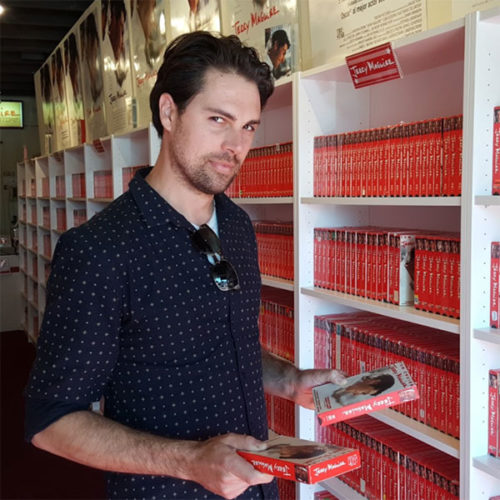
Andrew Mueller
Andrew G Mueller studied cinematography and film production at Chapman University where he received his BA. As a member of both IATSE Local 728 & ICG Local 600, he’s worked professionally as a Chief Lighting Technician and Cinematographer for over 15 years and traveled to 33 countries in the process. He resides in Los Angeles and spends his spare time woodworking, cooking, and processing medium format photography.

Bob Bates
Cinesouth is more than truckloads full of lights, custom equipment, and connections to talented crew; It’s also where they keep Bob Bates caged up in a padded cell. Bob began his career in the production industry in the early ’90s as a Production Assistant. Before that, he had a short but amazing career as a unicorn juggler, but that isn’t relevant right now.
Bob has worked for some pretty large and successful production companies, wearing every hat from Production Assistant, Sound, Grip, Production Manager, Producer, AD, and Director. He also once wore THIS HAT, but, again, not relevant. Bob has a great understanding of what it takes to make a production work – working within budget constraints; dealing with production staff and ad agency personnel; and ensuring the client receives the best possible product on time, on budget, and bull &#!% free.
In the film world, Bob has fine-tuned his natural talent as a Gaffer. A student of lighting who lives in the classroom that is feature film production, he loves the creativity of shaping light and exposing the eye to an unforeseen aspect or mode of a scene. The point is, you can get lights from many places, but you can only get Bob from here. Bob doesn’t just help you light your set, he helps you live the dream, especially if that dream involves juggling unicorns.
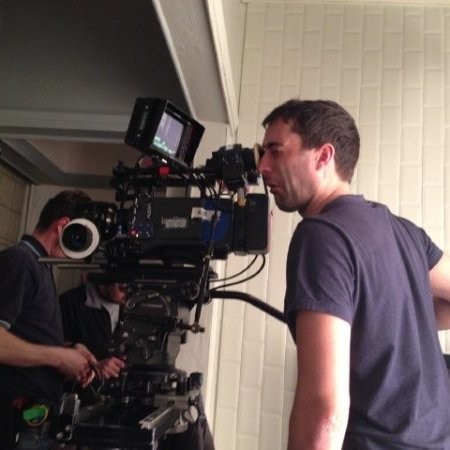
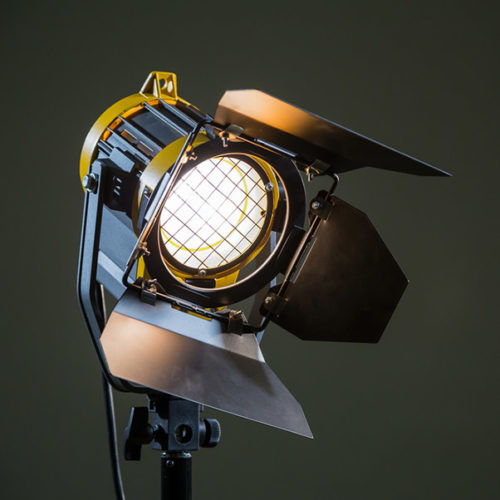
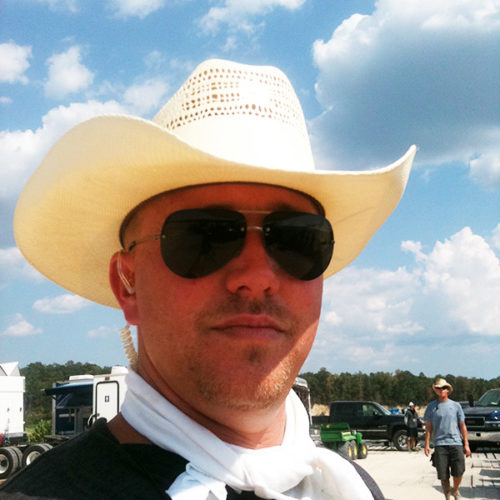
Jaim O’Neil
A Los Angeles native, Gaffer Jaim O’Neil has worked in the film industry for twenty-six years and loves what he does. He has traveled within the US and internationally to work on various films, with recent credits including Rampage, Bad Boys for Life, Lady and the Tramp, Unhinged, and The Secrets We Keep. He is a graduate of Los Angeles Valley College.

Cole Pisano
Cole Pisano has worked as a Gaffer on various commercials, music videos, and feature films.
Some of his commercial clients have included LG, Apple, Nike, Converse, Facebook, Pandora, State Farm, and Geico. He has also collaborated on music videos for Ice Cube (“Good Cop Bad Cop”), Zedd ft. Alessia Cara (“Stay”), Iggy Azalea (“Switch”), Halsey (“Colors”) and Nick Jonas (“Home”). Feature films credits include Shooting in Vain, Blackmark and The Boatman. Cole Pisano is based in Los Angeles.
He is a graduate of Wright State University.
References
- 1. "Gaffer Salary in Los Angeles, CA". Zip Recruiter. published: 11 December 2020. retrieved on: 18 December 2020
